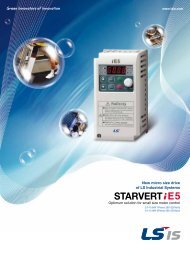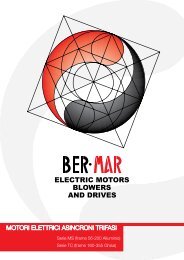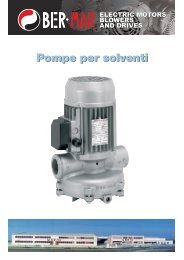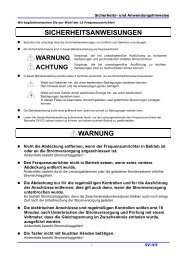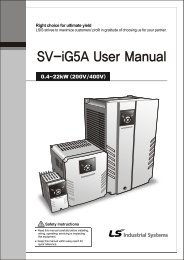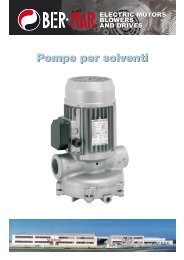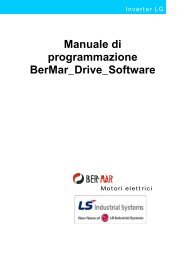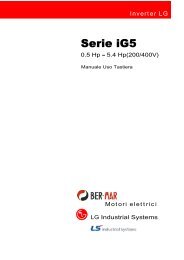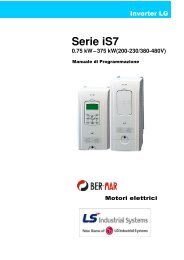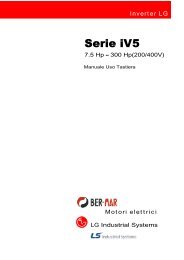Motori Elettrici Autofrenanti - Bermar.it
Motori Elettrici Autofrenanti - Bermar.it
Motori Elettrici Autofrenanti - Bermar.it
You also want an ePaper? Increase the reach of your titles
YUMPU automatically turns print PDFs into web optimized ePapers that Google loves.
DISPOSIZIONI COMMUTAZIONE<br />
Commutazione lato AC<br />
Quando si commuta a monte il raddrizzatore sul lato AC il<br />
campo magnetico decade lentamente. Con questo modo<br />
di commutazione il r<strong>it</strong>ardo di apertura è abbastanza<br />
lungo.<br />
La commutazione lato AC non necess<strong>it</strong>a di alcun sistema<br />
di protezione per la bobina e per i contatti di commutazione.<br />
Alla disconnessione i diodi raddrizzatori agiscono<br />
come diodi ad oscillazione libera.<br />
I tempi di commutazione t11 per la commutazione lato AC<br />
indicati a pagina 20 aumentano quando il raddrizzatore<br />
viene collegato direttamente alla morsettiera del motore<br />
2. Quando il motore rallenta viene applicata una tensione<br />
generatoriale ai morsetti del motore. Questo collegamento<br />
non è permesso per il funzionamento con invert<strong>it</strong>ore di<br />
frequenza.<br />
Per lunghezze di linea di oltre 10 m. tra il raddrizzatore e<br />
il freno per la commutazione lato AC le norme prescrivono<br />
l’uso di un interruttore separato 1. In questo caso la tensione<br />
di alimentazione può non essere presa dietro al relé<br />
motore 2. Se non è possibile installare un ulteriore interruttore<br />
diventa necessario l’uso di raddrizzatori speciali.<br />
Diagramma Tempo-Corrente<br />
Current-Time/Voltage-Time/Torque-Time Diagram<br />
SWITCHING ARRANGEMENTS<br />
AC-side Sw<strong>it</strong>ching<br />
When sw<strong>it</strong>ching before the rectifier on the AC-side the<br />
magnetic field decays slowly. At this mode of sw<strong>it</strong>ching<br />
the tripping delay is qu<strong>it</strong>e long.<br />
The AC-side sw<strong>it</strong>ching requires no protective measurements<br />
for the coil and the sw<strong>it</strong>ching contacts. On disconnection<br />
the rectifier diodes act as free-wheeling diodes.<br />
The sw<strong>it</strong>ching times t11 for AC-side sw<strong>it</strong>ching quoted on<br />
page 20 increase when the rectifier is connected directly<br />
in the motor terminal box 2. When the motor slows down<br />
a generatoric voltage is applied to the motor terminals.<br />
This wiring is not perm<strong>it</strong>ted for frequency inverter operation.<br />
For line lengths of more than 10 m. between rectifier and<br />
brake at AC-side sw<strong>it</strong>ching the regulations prescribe the<br />
use of a separate sw<strong>it</strong>ch 1. In this case the supply voltage<br />
may not be tapped behind the motor contactor 2. If <strong>it</strong> is<br />
not possible to install an add<strong>it</strong>ional sw<strong>it</strong>ch the use of special<br />
rectifiers becomes necessary.<br />
Tempo-Tensione/Tempo-Coppia nominale<br />
Wiring diagram<br />
t1<br />
t11<br />
t2<br />
= Tempo di inserimento<br />
= R<strong>it</strong>ardo della risposta all’inserimento<br />
= Tempo di disconnessione (disinnesto)<br />
t1<br />
t11<br />
t2<br />
= Engaging time<br />
= Engagement delay time<br />
= Release time<br />
74



